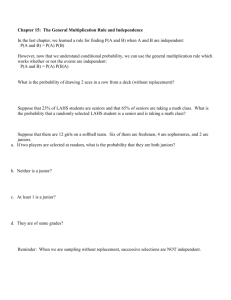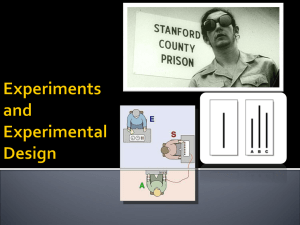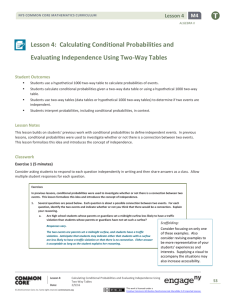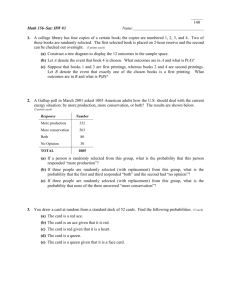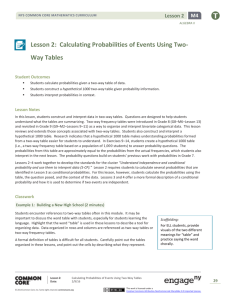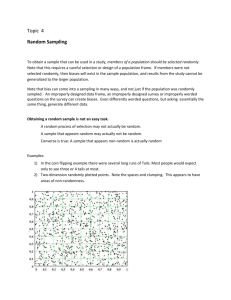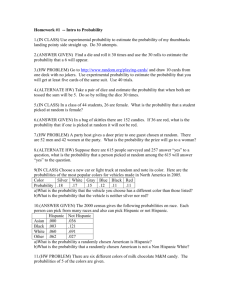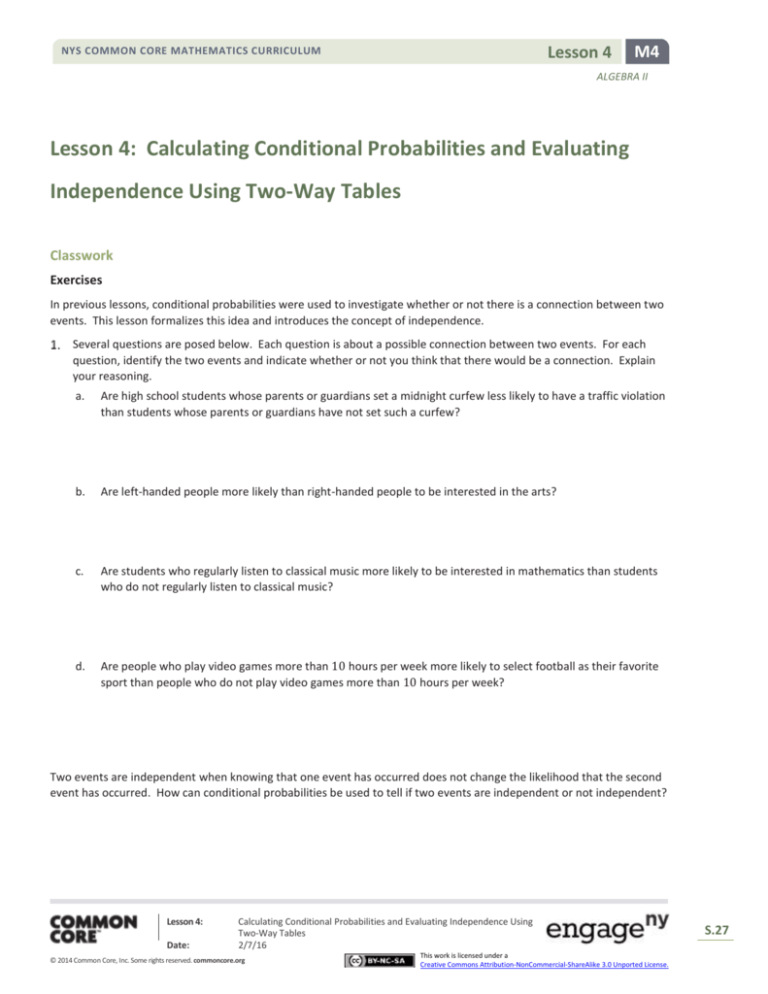
Lesson 4
NYS COMMON CORE MATHEMATICS CURRICULUM
M4
ALGEBRA II
Lesson 4: Calculating Conditional Probabilities and Evaluating
Independence Using Two-Way Tables
Classwork
Exercises
In previous lessons, conditional probabilities were used to investigate whether or not there is a connection between two
events. This lesson formalizes this idea and introduces the concept of independence.
Several questions are posed below. Each question is about a possible connection between two events. For each
question, identify the two events and indicate whether or not you think that there would be a connection. Explain
your reasoning.
a.
Are high school students whose parents or guardians set a midnight curfew less likely to have a traffic violation
than students whose parents or guardians have not set such a curfew?
b.
Are left-handed people more likely than right-handed people to be interested in the arts?
c.
Are students who regularly listen to classical music more likely to be interested in mathematics than students
who do not regularly listen to classical music?
d.
Are people who play video games more than 10 hours per week more likely to select football as their favorite
sport than people who do not play video games more than 10 hours per week?
Two events are independent when knowing that one event has occurred does not change the likelihood that the second
event has occurred. How can conditional probabilities be used to tell if two events are independent or not independent?
Lesson 4:
Date:
Calculating Conditional Probabilities and Evaluating Independence Using
Two-Way Tables
2/7/16
© 2014 Common Core, Inc. Some rights reserved. commoncore.org
This work is licensed under a
Creative Commons Attribution-NonCommercial-ShareAlike 3.0 Unported License.
S.27
Lesson 4
NYS COMMON CORE MATHEMATICS CURRICULUM
M4
ALGEBRA II
Recall the hypothetical 1000 two-way frequency table that was used to classify students at Rufus King High School
according to gender and whether or not they participated in the after-school athletic program.
Table 1
Participation in the after-school athletic program (Yes or No) of males and females
Participate in the after-school
athletic program
Do not participate in the afterschool athletic program
Total
Females
Males
Total
For each of the following, indicate whether the probability described is one that can be calculated using the values
in Table 1. Also indicate whether or not it is a conditional probability.
a.
The probability that a randomly selected student participates in the after-school athletic program.
b.
The probability that a randomly selected student who is female participates in the after-school athletic
program.
c.
The probability that a randomly selected student who is male participates in the after-school athletic program.
Use Table 1 to calculate each of the probabilities described in Exercise 2.
a.
The probability that a randomly selected student participates in the after-school athletic program.
b.
The probability that a randomly selected student who is female participates in the after-school athletic
program.
Lesson 4:
Date:
Calculating Conditional Probabilities and Evaluating Independence Using
Two-Way Tables
2/7/16
© 2014 Common Core, Inc. Some rights reserved. commoncore.org
This work is licensed under a
Creative Commons Attribution-NonCommercial-ShareAlike 3.0 Unported License.
S.28
Lesson 4
NYS COMMON CORE MATHEMATICS CURRICULUM
M4
ALGEBRA II
c.
The probability that a randomly selected student who is male participates in the after-school athletic program.
Would your prediction of whether or not a student participates in the after-school athletic program change if you
knew the gender of the student? Explain your answer.
Two events are independent if knowing that one event has occurred does not change the probability that the other
event has occurred. For example, consider the following two events:
𝐹: the event that a randomly selected student is female
𝑆: the event that a randomly selected student participates in the after-school athletic program.
𝐹 and 𝑆 would be independent if the probability that a randomly selected student participates in the after-school
athletic program is equal to the probability that a randomly selected student who is female participates in the afterschool athletic program. If this were the case, knowing that a randomly selected student is female does not change the
probability that the selected student participates in the after-school athletic program. Then 𝐹 and 𝑆 would be
independent.
Based on the definition of independence, are the events randomly selected student is female and randomly selected
student participates in the after-school athletic program independent? Explain.
A randomly selected student participates in the after-school athletic program.
a.
What is the probability this student is a female?
b.
Using only your answer from part (a), what is the probability that this student is a male? Explain how you
arrived at your answer.
Lesson 4:
Date:
Calculating Conditional Probabilities and Evaluating Independence Using
Two-Way Tables
2/7/16
© 2014 Common Core, Inc. Some rights reserved. commoncore.org
This work is licensed under a
Creative Commons Attribution-NonCommercial-ShareAlike 3.0 Unported License.
S.29
Lesson 4
NYS COMMON CORE MATHEMATICS CURRICULUM
M4
ALGEBRA II
Consider data below.
Student indicates he or she
has asthma
Student indicates he or she
does not have asthma
Total
No household
member smokes
At least one household
member smokes
Total
𝟔𝟗
𝟏𝟏𝟑
𝟏𝟖𝟐
𝟒𝟕𝟑
𝟐𝟖𝟐
𝟕𝟓𝟓
𝟓𝟒𝟐
𝟑𝟗𝟓
𝟗𝟑𝟕
You are asked to determine if the two events a randomly selected student has asthma and a randomly selected
student has a household member who smokes are independent. What probabilities could you calculate to answer
this question?
Calculate the probabilities you described in Exercise 7.
Based on the probabilities you calculated in Exercise 8, are these two events independent or not independent?
Explain.
Is the probability that a randomly selected student who has asthma and who has a household member who smokes
the same as or different than the probability that a randomly selected student who does not have asthma but does
have a household member who smokes? Explain your answer.
A student is selected at random. The selected student indicates that he or she has a household member who
smokes. What is the probability that the selected student has asthma?
Lesson 4:
Date:
Calculating Conditional Probabilities and Evaluating Independence Using
Two-Way Tables
2/7/16
© 2014 Common Core, Inc. Some rights reserved. commoncore.org
This work is licensed under a
Creative Commons Attribution-NonCommercial-ShareAlike 3.0 Unported License.
S.30
Lesson 4
NYS COMMON CORE MATHEMATICS CURRICULUM
M4
ALGEBRA II
Lesson Summary
Data organized in a two-way frequency table can be used to calculate conditional probabilities.
Two events are independent if knowing that one event has occurred does not change the probability that the
second event has occurred.
Probabilities calculated from two-way frequency tables can be used to determine if two events are independent or
not independent.
Problem Set
1.
Consider the following questions.
a.
A survey of the students at a Midwest high school asked the following questions:
“Do you use a computer at least 3 times a week to complete your school work?”
“Are you taking a mathematics class?”
Do you think the events a randomly selected student is taking a mathematics class and a randomly selected
student uses a computer at least 3 times a week are independent or not independent? Explain your reasoning.
b.
The same survey also asked students the following:
“Do you participate in any extracurricular activities at your school?”
“Do you know what you want to do after high school?”
Do you think the events a randomly selected student participates in extracurricular activities and a randomly
selected student knows what he or she wants to do after completing high school are independent or not
independent? Explain your reasoning.
c.
People attending a professional football game in 2013 completed a survey that included the following
questions:
“Do you think football is too violent?”
“Is this the first time you have attended a professional football game?”
Do you think the events a randomly selected person who completed the survey is attending a professional
football game for the first time and a randomly selected person who completed the survey thinks football is too
violent are independent or not independent? Explain your reasoning.
Complete the table below in a way that would indicate the two events uses a computer and is taking a mathematics
class are independent.
Uses a computer at least 𝟑
times a week for school work
Date:
Total
𝟕𝟎𝟎
In a mathematics class
Not in a mathematics class
Total
Lesson 4:
Does not use a computer at least
𝟑 times a week for school work
𝟔𝟎𝟎
𝟏, 𝟎𝟎𝟎
Calculating Conditional Probabilities and Evaluating Independence Using
Two-Way Tables
2/7/16
© 2014 Common Core, Inc. Some rights reserved. commoncore.org
This work is licensed under a
Creative Commons Attribution-NonCommercial-ShareAlike 3.0 Unported License.
S.31
Lesson 4
NYS COMMON CORE MATHEMATICS CURRICULUM
M4
ALGEBRA II
Complete the following hypothetical 1000 table. Are the events participates in extracurricular activities and know
what I want to do after high school independent or not independent? Justify your answer.
Participate in
extracurricular activities
Know what I want to do after
high school
Do not know what I want to
do after high school
Total
Do not participate in
extracurricular activities
Total
𝟖𝟎𝟎
𝟓𝟎
𝟔𝟎𝟎
𝟏, 𝟎𝟎𝟎
The following hypothetical 1000 table is from Lesson 2.
Student indicates he or she
has asthma
Student indicates he or she
does not have asthma
Total
No household
member smokes
At least one household
member smokes
Total
𝟕𝟑
𝟏𝟐𝟎
𝟏𝟗𝟑
𝟓𝟎𝟔
𝟑𝟎𝟏
𝟖𝟎𝟕
𝟓𝟕𝟗
𝟒𝟐𝟏
𝟏, 𝟎𝟎𝟎
No household
member smokes
At least one household
member smokes
Total
𝟔𝟗
𝟏𝟏𝟑
𝟏𝟖𝟐
𝟒𝟕𝟑
𝟐𝟖𝟐
𝟕𝟓𝟓
𝟓𝟒𝟐
𝟑𝟗𝟓
𝟗𝟑𝟕
The actual data from the entire population is given in the table below.
Student indicates he or she
has asthma
Student indicates he or she
does not have asthma
Total
a.
Based on the hypothetical 1000 table, what is the probability that a randomly selected student who has
asthma has at least one household member who smokes?
b.
Based on the actual data, what is the probability that a randomly selected student who has asthma has at least
one household member who smokes (round your answer to 3 decimal places)?
c.
Based on the hypothetical 1000 table, what is the probability that a randomly selected student who has no
household member who smokes has asthma?
d.
Based on the actual data, what is the probability that a randomly selected student who has no household
member who smokes has asthma?
e.
What do you notice about the probabilities calculated from the actual data and the probabilities calculated
from the hypothetical 1000 table?
Lesson 4:
Date:
Calculating Conditional Probabilities and Evaluating Independence Using
Two-Way Tables
2/7/16
© 2014 Common Core, Inc. Some rights reserved. commoncore.org
This work is licensed under a
Creative Commons Attribution-NonCommercial-ShareAlike 3.0 Unported License.
S.32
Lesson 4
NYS COMMON CORE MATHEMATICS CURRICULUM
M4
ALGEBRA II
As part of the asthma research, the investigators wondered if students who have asthma are less likely to have a pet
at home than students who do not have asthma. They asked the following two questions:
“Do you have asthma?”
“Do you have a pet at home?”
Based on the responses to these questions, you would like to set up a two-way table that you could use to
determine if the following two events are independent or not independent:
Event 1: a randomly selected student has asthma
Event 2: a randomly selected student has a pet at home.
a.
What would you use to label the rows of the two-way table?
b.
What would you use to label the columns of the two-way table?
c.
What probabilities would you calculate to determine if Event 1 and Event 2 are independent?
Lesson 4:
Date:
Calculating Conditional Probabilities and Evaluating Independence Using
Two-Way Tables
2/7/16
© 2014 Common Core, Inc. Some rights reserved. commoncore.org
This work is licensed under a
Creative Commons Attribution-NonCommercial-ShareAlike 3.0 Unported License.
S.33


